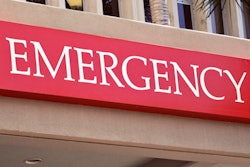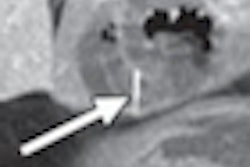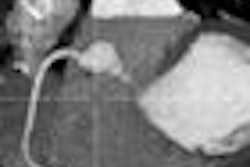The use of CT in emergency departments (EDs) has risen sharply in the past decade, and it's not hard to find opposition to the kinds of growth numbers that some find alarming. But there has been little opposition to an ongoing drop in hospital admissions, and now a study in the Annals of Emergency Medicine has linked the two trends.
Based on data from close to 100 million patients receiving CT scans in the ED, researchers found that CT use increased by 330% between 1996 and 2007 -- most strikingly for patients presenting with abdominal and flank pain. Over the same time period, the likelihood of hospital admission after a CT scan has fallen by half, though the trend toward lower admissions has leveled off in recent years.
"The likelihood of hospitalization or transfer after a CT declined throughout the study period," wrote Dr. Keith Kocher, from the University of Michigan, and colleagues from three other U.S. Institutions. "However, the rate of change diminished and leveled off after 2003, despite a continuous increase in the adjusted overall rate of CT use" (Ann Emerg Med, August 9, 2011).
Using data from the National Hospital Ambulatory Medical Care Survey, the researchers examined emergency department CT use from 1996 to 2007, as well as hospital admission rates among individuals receiving CT scans. The data were analyzed to assess changes in CT use during an ED visit, CT use for specific patient complaints, and patient management after scanning with CT. The primary outcome for the analysis was whether at least one CT scan was performed during an ED visit.
Multivariable logistic regression models examined the association between CT use during an ED visit and year, patient demographics, visit characteristics, and hospital factors. The researchers also looked at the association between an ED visit and the presenting patient's complaint, and the association between CT use during an ED visit and hospitalization or transfer to another facility during the study years.
"We found that CT use in the ED setting has been increasing rapidly during the past 12 years and that the ED is now responsible for almost one-quarter of the studies performed in the United States," Kocher and colleagues wrote. "Although its growing use is occurring across a broad range of patients, it has been particularly high for those with certain conditions, including abdominal pain, flank pain, chest pain, and shortness of breath."
Over the study period, CT use during emergency department visits increased 330%, from 3.2% (95% confidence interval [CI]: 2.9%-3.6%) of encounters in 1996 to 13.9% (95% CI: 12.8%-14.9%) in 2007. After multivariable adjustment, there was a threefold increase in the likelihood of CT use over time (adjusted risk ratio [RR]: 3.11; 95% CI: 2.77-3.48).
"However, this growth was not evenly distributed by age, with a more dramatic increase in CT use observed among older patients," the authors wrote. For example, 9.1% of all patients older than 79 received a CT scan in 1996, but this figure increased to 29.1% in 2007.
Among patients younger than 18 years, the use of CT grew from 1.1% in 1996 to 5.2% in 2007. CT scans were performed more often for whites than for other racial groups; however, the rate of growth was similar across all groups over the study period, the group reported.
The biggest growth was seen in patients presenting with abdominal pain, in which the likelihood of undergoing a CT scan was almost 10 times higher in 2007 compared with 1996 (adjusted RR: 9.97; 95% CI: 7.47-12.02). Ranked second in growth was the likelihood of receiving a CT scan based on flank pain (adjusted RR: 9.24; 95% CI: 6.22-11.51), followed by chest pain (adjusted RR: 5.54; 95% CI: 3.75-7.53) and shortness of breath (adjusted RR: 5.28; 95% CI: 2.76-8.34).
By 2007, more than 25% of patients with the following conditions underwent CT during their emergency department visit.
Emergency department CT use by indication: 2007
|
On the positive side, the likelihood of hospitalization or transfer after a CT scan declined throughout the study period, from 26.0% in 1996 to 12.1% in 2007; however, the rate of change associated with a CT scan diminished and leveled off after 2003, according to the group. "Despite a continued increase in CT use, the relative risk of admission or transfer for those undergoing CT has plateaued in recent years," they wrote.
By 2007, about one in seven patients visiting the emergency department had a CT scan as part of their evaluation. "Given the large number of patients being treated annually in EDs, this finding has enormous implications for the general population," the authors wrote.
Many causes of the growing CT use in the U.S. have been suggested, they wrote, including:
- Technological advances leading to expanded indications
- Increased availability of CT scanners
- Favorable financial reimbursement for imaging procedures
- Shifts in the practice of medicine that include more time constraints and promote defensive medicine
"Many of these have important roles in the ED, but the extent to which each is responsible for increasing CT use in this particular environment is uncertain," the authors wrote. "As in other settings, the reasons for ordering a CT during any single ED patient encounter can be complex and multifactorial."
The results suggest that CT scans performed in the emergency department may lead to reduced frequency of hospitalization or transfer, as shown in a relative reduction in the risk of transfer of patients receiving a CT of 0.42 (95% CI: 0.32-0.55) in 2007 compared to 1996. CT may also be affecting decisions about where hospital admissions occur, with a possible shift away from intensive care. "This difference suggests that CT use may also prevent [intensive care unit (ICU)] admissions, perhaps shifting these hospitalizations toward a non-ICU bed," the authors wrote.
Although the growing use of CT is occurring across a broad range of patients, "it has been particularly high for those with certain conditions, including abdominal pain, flank pain, chest pain, and shortness of breath," Kocher and colleagues concluded. "Research on understanding how and under what conditions CT is being performed in the ED and developing better strategies for optimizing its use in this setting is needed."
"It seems inevitable that any good tool will be overused at some point; in fact, that is how we learn where the boundaries of diminishing returns are," wrote Dr. Robert Wears, from the University of Florida, in an editorial accompanying the study. "What is acceptable and appropriate use or nonuse of CT imaging is not an entirely objective question that can be neatly resolved by empirical data and formal analysis, but rather a tangled, socially constructed issue involving competing views of risk, benefit, and obligation, and the elusive question of how much certainty we must have."
Much of the increase is probably related to changes in how doctors practice medicine and the availability of CT scanners, said lead author Kocher in a statement accompanying the study's publication. CT scans "provide lots of information quickly, and so doctors and patients see CTs as a means of arriving at diagnoses efficiently and conveniently," he said. "Couple that with the fact that CT scanners are commonly housed in or near the ED itself, and the barriers to getting the test done are lower than in the past."




















